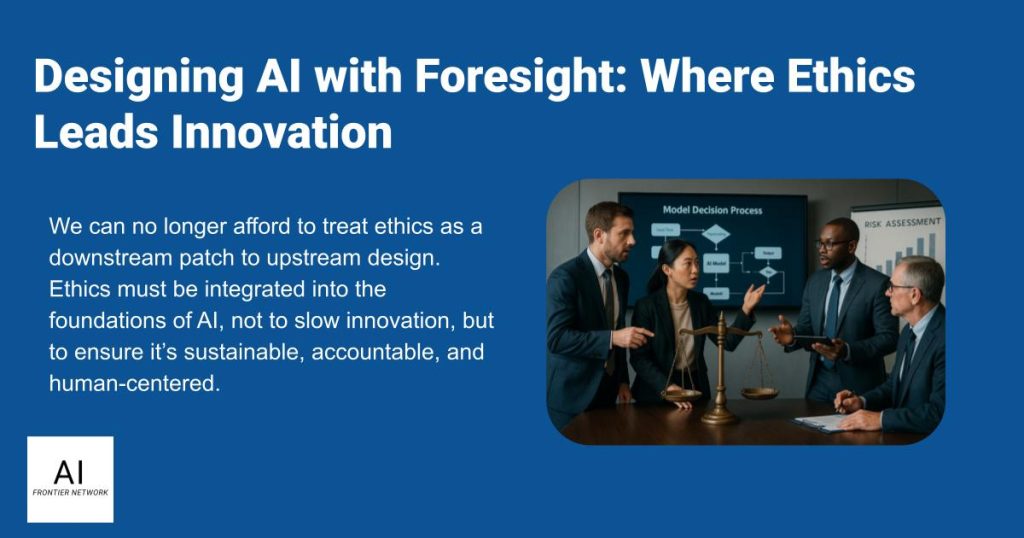
Synthetic intelligence is reworking how choices are made in every part from credit score approvals to healthcare diagnostics. But as AI techniques grow to be extra autonomous, questions of duty, equity, and trustworthiness are extra pressing than ever. Whereas mannequin efficiency continues to speed up, moral safeguards have lagged behind. We will now not afford to deal with ethics as a downstream patch to upstream design. Ethics should be built-in into the foundations of AI, to not gradual innovation, however to make sure it’s sustainable, accountable, and human-centered.
Transparency: Not Publicity, however Engineering
True AI transparency isn’t about revealing proprietary code. It’s about providing structured perception into how techniques perform and what penalties they produce. Rahul B., who has labored in regulated digital finance techniques, argues that explainability and auditability may be embedded “by design”—as they’re in compliant monetary software program. He and Topaz Hurvitz advocate for architectural transparency: utilizing model-agnostic explanations, audit logs, and sandboxed determination visualizations to make advanced fashions interpretable with out compromising mental property.
Sudheer A. and Niraj Okay Verma echo this view, emphasizing that explainability should prolong past technical groups to regulators, auditors, and end-users. Transparency isn’t a disclosure technique—it’s a system structure that anticipates accountability.
Bias Is Not a Bug—It’s a Lifecycle Danger
Too usually, AI bias is handled as a technical flaw to be fastened by builders alone. However bias is structural. As Ram Kumar N. places it, figuring out and addressing it should be “a team sport” involving engineers, designers, authorized groups, and finish customers alike. Arpna Aggarwal reinforces this level, arguing that bias mitigation is handiest when it combines technical instruments, like equity metrics and artificial knowledge, with organizational processes reminiscent of real-time monitoring and human oversight throughout deployment.
Amar Chheda introduces a important nuance: not all biases are unethical. Viewers segmentation, as an illustration, could improve advertising and marketing relevance. Nevertheless, when such methods grow to be exploitative, as within the deliberate design of girls’s clothes with smaller pockets to advertise purse gross sales, the moral boundary is crossed. AI forces us to confront the dimensions and subtlety of such choices, particularly when the system, not the human, is making the decision.
Governance Requires Extra Than Ideas
A typical theme throughout sectors is the necessity for proactive governance. Srinivas Chippagiri warns in opposition to one-off audits, describing bias as a persistent vulnerability that should be monitored like cybersecurity threats. In the meantime, Dmytro Verner and Shailja Gupta argue for establishing cross-functional governance groups with shared duty, spanning mannequin design, authorized compliance, and threat evaluation. Rahul B. helps this mannequin, describing cross-functional charters that deal with bias not as a technical subject however as a strategic design problem.
Rajesh Ranjan notes that governance isn’t merely inside; it additionally contains public-facing mechanisms. Transparency reviews, stakeholder disclosures, and third-party audit frameworks are essential in constructing public belief. With out seen checks and balances, moral claims stay aspirational.
A Shared Ethics Framework: Pressing, However Not Uniform
Regardless of cultural, regulatory, and industrial variation, there may be broad settlement on the necessity for a worldwide moral framework. Suvianna Grecu likens this to fields like medication and regulation, the place worldwide requirements allow native adaptation with out sacrificing moral consistency. Junaith Haja proposes a set of core ideas: equity, transparency, accountability, safety, and human oversight. These may function the spine of any ethics constitution, whereas remaining versatile for sector-specific implementation.
Nevertheless, as Sai Saripalli and Devendra Singh Parmar warning, ethics can’t be dictated solely by governments or firms. Efficient frameworks should be co-created by collaboration between technologists, regulators, civil society, and academia. Business-driven ethics, whereas invaluable, can hardly ever maintain themselves accountable.
Ethics Should Be Intentional, Not Aspirational
Maybe the clearest takeaway from the insights shared is that moral AI should be intentional. As Hina Gandhi notes, creating devoted “ethics auditors” and institutionalizing duty are sensible—not theoretical—steps. Sanjay Temper warns that management should personal moral outcomes early within the course of; by the point flaws are found downstream, it’s usually too late to right them with out public hurt.
This view is bolstered by EBL Information and Shailja Gupta, who advocate for decentralized however enforceable buildings. Moral infrastructure should be as sturdy as technical structure: recurrently audited, transparently ruled, and tied to incentives.
Conclusion: The Way forward for AI Depends upon What We Construct Into It
AI isn’t impartial. Each mannequin displays the assumptions, incentives, and values of its creators. If we design for velocity and effectivity alone, we are going to construct techniques that amplify present inequities and obscure accountability. But when we design with conscience—embedding transparency, managing bias, and structuring governance—we are able to construct techniques that help human flourishing quite than change it.
Ethics isn’t the other of innovation. It’s what makes innovation value trusting.




